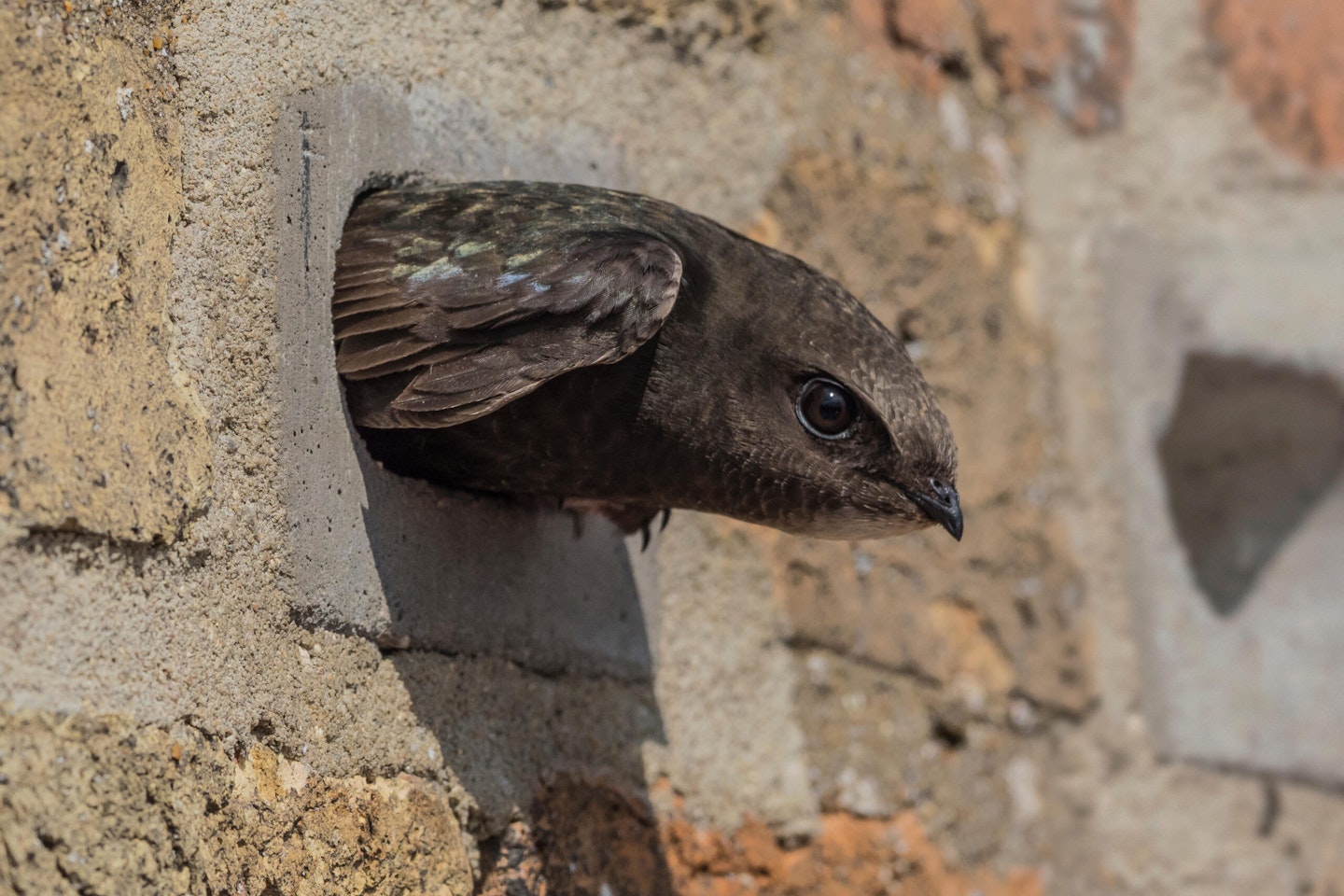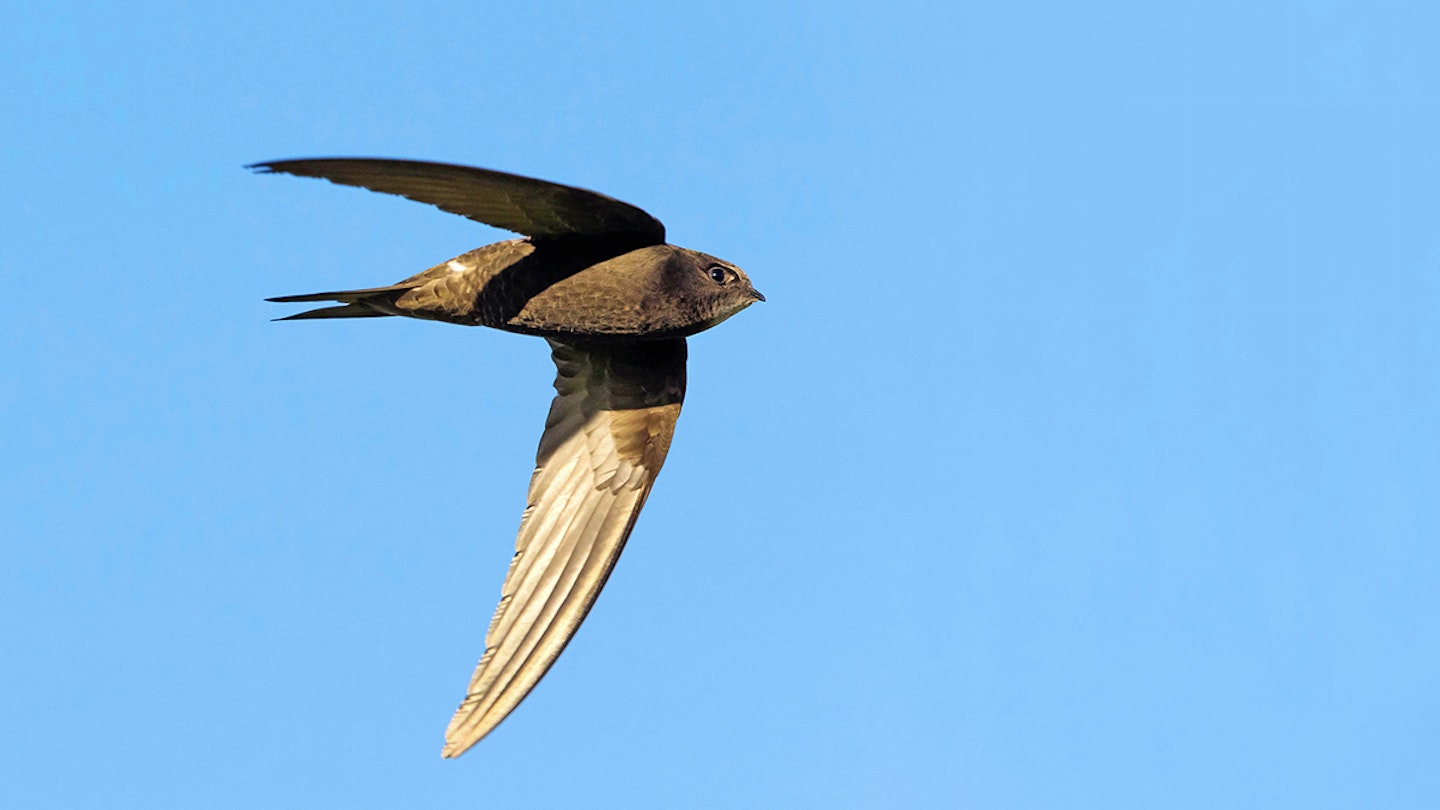An encounter with a stricken bird gave this author the opportunity to get up close and personal with a wonderful aerial acrobat
Scientifc name: Apus apus
Length: 16-17cm
Wingspan: 42-48cm
UK numbers: 59,000 breeding pairs
Habitat: In the air!
Diet: Flying insects and airborne spiders
It was one of those moments when nature takes you by the scruff of the neck, unsettles you and reminds you how savage and alien it can be. And it took place in a churchyard in rural Dorset, on ground where the Bluebells were so dense and overwhelming that they might as well have been singing. My senses were happily drinking in this sweet spring over-ripe abundance, and I wasn’t prepared for reality interrupting it.
However, some players in a dark drama were determined to disturb the loveliness. A pair of Carrion Crows were pecking at something on the ground, as shifty as feral teenagers. But that is hardly unusual, and it was only when I realised that a pair of Magpies were active nearby that it became clear something sinister was going on. They were attacking a bird. This was a near-midsummer murder attempt – a murder of crows, no less.
I intervened – of course I did. I chased the Magpies away and soon realised that they were assaulting a Swift. It was flailing on the ground, in clear distress, although still alive. There was no blood, but the Swift was at the very least dazed, and there was some evidence that it was neurologically compromised. Either way, the unfortunate creature was weakened and vulnerable. I picked it up, folded its wings in and placed it in a box in the church porch. It looked as though it would expire at any moment.
Extraordinary bird
This, a cameo that occurred a short time ago, was the only occasion I have ever handled a Swift. In those brief moments, the shock of the savagery exacted upon the Swift gave way to the sheer realisation of just how singularly extraordinary this bird is, something magnified close up.
Personally, my biggest surprise was to experience the grasp of the Swift’s feet. Back in the day, all the books would tell you that the feet of Swifts were so small and insignificant that the scientific name of the family was Apodidae (a-pod=no feet). Other technical books explained that Swifts were unique for having four toes facing the same way, forwards, an arrangement described as ‘pamprodactyl’.
Well, you only have to handle a Swift for a short time to debunk both those myths. While I was trying to manoeuvre it into the box, the Swift gripped my finger so tightly that it made a lasting mark with its claws, although it didn’t quite draw blood. It also clearly held on with two toes facing forward and two pointing back (apparently dead Swift specimens naturally set with four toes pointing forwards.)
Every account of Swifts that you read marvels at their aerial lifestyle, but we need to remember that, for about a month of the year, they are incubating eggs or brooding chicks on a solid surface, be that a crevice, a ledge, an old bird nest or a specially designed Swift box. Furthermore, they are also fully capable of roosting on vertical surfaces, particularly when the weather is bad. They are acquainted with more than fresh air.
Indeed, one of the Swift’s most famous aerial stunts, one frequently put forward as the ultimate in adaptations for their lifestyle, is their ability to copulate in the air. What people forget is that, regardless of this ability, Swifts routinely mate at the nest site and this is surely the normal way of doing it – you would think that the fertilisation rate would be higher on solid ground. However, there is no doubt that Swifts come together in the air sometimes – there is a special and rather wonderful display that culminates in one bird mounting another, albeit briefly, in flight – and it has been suggested that these might be lightning quick liaisons between individuals that are paired to somebody else.
Swifts also, famously, sleep on the wing, but once again it should be remembered that many also sleep at the nest site. They build a nest on a solid surface, compacting what they might catch in the air – an itinerant piece of hay, perhaps, a feather or other flying flotsam – with copious amount of saliva, making a shallow cup. Their aerial mastery cannot be doubted, but they are not one-trick ponies. We need to grasp what they can grasp.
That said, any moment trying to save a stricken Swift also alerts you to those amazing wings. I might have been surprised by the Swift’s claws, but the wings were simply magnificent, evoking awe rather than shock. It is no coincidence that these limbs are sometimes described as sabre-shaped, because close to they look like weapons. You can imagine challenging somebody to a duel with them and threatening to smite your opponent. Those wings of wonder, with their supreme sharp points, are what makes Swifts special, and also somewhat alien.
Swifts are related to Hummingbirds, and like those titches they have greatly reduced arms and extended digits, meaning that they effectively fly with their fingers. The slightest twitch from a finger helps them to dial-in on a flying insect and snatch it with their bill.
People often think that Swifts simply graze, open-jawed, through the insect-laden summer skies, but the reality is quite different and far more impressive. Every insect or other invertebrate is seized individually. Swifts have evolved to ply the skies with wondrous precision. There are few birds that are so entertaining to watch. Observe a Black-tailed Godwit or some such probing in the watery mud, or watch a sparrow peck at seeds, and the thrill wears off. But you could never tire of watching the twists, turns, sweeps and careening movements of a foraging Swift.

Flights of fancy
Those wings are so efficient at keeping Swifts aloft that they are indeed able to accommodate moments of sleep. It isn’t quite sleep as we know it, perhaps little more than naps caught on the breeze, as the bird gradually descends. And even the snatches of sleep are only literally half-sleeps because, amazingly, a Swift rests only half its brain at a time, keeping the other awake. It would take quite a flight of the imagination to perceive what that might be like, napping on the gentle zephyrs of the short summer night, half-asleep, half-awake. Would a Swift dream and, if so, what about?
And talk about flights of fancy, what about the Swift’s astonishing migration? After breeding, it goes south to whisk over the western coast of Africa, down into the Congo basin, where it spends some weeks, doubtless eating flying insects unknown to us and undescribed by scientists.
Not content with such a ‘short’ hop, it then travels east to take advantage of seasonal insect swarms as far as the eastern coast of Africa, in northern Mozambique. A British Swift could spend our late autumn over the Indian Ocean.
For now, though, my own Swift’s prospects had been severely threatened. After half an hour it seemed to have recovered a little, and even called to its mate. I dared to hope. Once again, its grip on me was strong – actually, it hurt.
It was a windy day. I took the Swift to the highest point I could find. Releasing its grip, I threw it up into the air, knowing that at worst it would make an embarrassing landing. Hope lifted as it caught a breeze and whirled upwards, looking, it must be said, more like a learner flier rather than a supreme master of the air. After a few circuits it came to rest near the top of the church’s tower, hopelessly out of reach. I cannot tell you its fate. Nature is marvellous, but its flipside is brutal, the two separated by less than a flick of the wings.
Where to see them
This summer visitor breeds across the UK but most numerously in the south and east. Look high in the sky for excited screaming parties of them. They winter in Africa.
